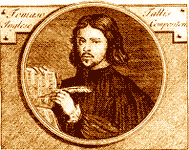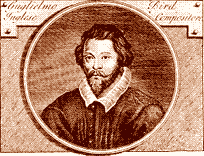Chapter 12 - THREE COMPOSERS
HOME | contents | << | tallis | byrd | gibbons | gibbons the musician | gibbons & weelkes - 'Hosanna' | TALLIS |
TALLIS |  4 voice mass (tallis)
4 voice mass (tallis)
Tallis, the earliest in date of the three great names, produces work which is always technically fine and
serves I as a model to be copied and improved upon by his pupil Byrd.
The direct, classical quality of his style was more the product of his own genius than the result of
modelling himself on the technical complexities of his precursors.
Tallis at the time of the publication of the Book of Common
Prayer was already a man of forty-five or so and the bulk of his work was written to Latin words;
for that reason it smacks of the
continental Palestrina style
![]() (Kyrie - Westminster Cathedral choir: music details HERE.)
which relies more than later English work on purely musical methods to attain its effect.
If Tallis had composed more to
vernacular texts it is possible that his genius would have been moved to new paths of expression;
but thus to carp is merely to
say that his music was of its time.
His genius made his work monumental, grand and flawless, a perfect model for the youthful Byrd
who called him 'a father in musicke'.
The five-part Salvator mundi,
(Kyrie - Westminster Cathedral choir: music details HERE.)
which relies more than later English work on purely musical methods to attain its effect.
If Tallis had composed more to
vernacular texts it is possible that his genius would have been moved to new paths of expression;
but thus to carp is merely to
say that his music was of its time.
His genius made his work monumental, grand and flawless, a perfect model for the youthful Byrd
who called him 'a father in musicke'.
The five-part Salvator mundi,![]() (Winchester Cathedral choir: music details HERE.)
which has become part of
the modern repertory attempts something more and achieves an unforgettable fusion of the grand style and a moving pathos, which
reflects the emotion of the text.
The clashing English sevenths on the word redemisti, the effective repeat at the
beginning - a device more common in the madrigals than in the motets, here consummately used to drive home the urgency of the cry Salvator
mundi, salva nos - the repeated note figure on auxiliare,
like the earnest utterance of a crowd, and the long downward movement in pitch, dynamics and intensity of feeling of the last two
pages are all used with the unconscious greatness of genius without once halting the onward march of the music.
(Winchester Cathedral choir: music details HERE.)
which has become part of
the modern repertory attempts something more and achieves an unforgettable fusion of the grand style and a moving pathos, which
reflects the emotion of the text.
The clashing English sevenths on the word redemisti, the effective repeat at the
beginning - a device more common in the madrigals than in the motets, here consummately used to drive home the urgency of the cry Salvator
mundi, salva nos - the repeated note figure on auxiliare,
like the earnest utterance of a crowd, and the long downward movement in pitch, dynamics and intensity of feeling of the last two
pages are all used with the unconscious greatness of genius without once halting the onward march of the music.
 BYRD |
BYRD |  ave verum (byrd)
ave verum (byrd)
Byrd caught the nobility of style of his master and fused into it a new, more human pathos;
the resulting
music is wonderfully rich, like Shakespeare at his finest, where oratory and feeling combine to make great art.
Byrd, despite his rather over-developed sense of justice and his consequent love of law-suits, was a
serious-minded man as well as the most accomplished master of music technique in his day:
he could handle his eight parts with
ease as well as cling stubbornly to his Roman faith in days when that sometimes meant the threat of execution.
But he had other
qualities:
he believed in his heart as well as in his mind the dogmas of his faith (a rarity even in serious-minded men) and could
in addition carry over into his music his strong emotional conviction.
The result is a giant in music who even in experimental
work like his keyboard pieces could surpass all his contemporaries.
His mind attuned to great things loved to toil at a large
canvas with a serious subject; the lighter side of madrigal writing was not in his make-up, but he could at times produce
miniatures as fascinating as Christe qui lux, with its simple chordal setting of a plainsong compline hymn,
and the moving Ave
verum corpus ![]() (Westminster Cathedral choir: music details HERE.).
With space in which
to work, however, he is more at home and is certain to produce majestic and highly vitalised music suited to the inspiring texts
he chose.
(Westminster Cathedral choir: music details HERE.).
With space in which
to work, however, he is more at home and is certain to produce majestic and highly vitalised music suited to the inspiring texts
he chose.
 GIBBONS |
GIBBONS |  drop, drop small tears (gibbons)
drop, drop small tears (gibbons)
The third great name, Gibbons, brings us to music of a different sort.
Gibbons was more 'English' than the
others and a protestant;
he wrote only to English texts and like all protestants had his feet firmly set on the earth.
He is moved more by the drama of human things than by the dogmas of the theologians.
If he could thrill to
the dramatic Palm Sunday story in Hosanna to the son of David he loves rather to linger over words like 'look upon our
infirmities', 'in all our dangers and necessities', or 'O Lord, increase my faith', the eternal cry of the Christian struggling in
a world at odds with his ideals.
He shows to advantage in the two saint's day anthems, one for John Baptist -
This is the
record of John ![]() (Winchester Cathedral choirs: music details HERE.) -
and the other for Peter - Almighty God, who by thy Son.
The human
touch in both is new and unmistakable;
in the former the conversation gives a vivid character sketch of the baptist's blunt
vigour;
and he answered, No is set to a short, almost unmannerly cadence, while the earnest heart beating beneath the
camel's hair shirt is felt in the impassioned utterance and he said, I am the voice of him that crieth in the wilderness.
No one can forget the simple, telling effect of the word earnestly in the Peter anthem. Gibbons, in fact, shows almost a
romantic tendency, a judgment corroborated by the study of his madrigals, which are often tinged with a sorry cynicism, the sure
sign of a romantic.
Gibbons' faith is not the easy faith and adoration of Tallis and Byrd in an incense-breathing milieu but shows
the heart-searchings and questionings of a thoughtful protestant.
(Winchester Cathedral choirs: music details HERE.) -
and the other for Peter - Almighty God, who by thy Son.
The human
touch in both is new and unmistakable;
in the former the conversation gives a vivid character sketch of the baptist's blunt
vigour;
and he answered, No is set to a short, almost unmannerly cadence, while the earnest heart beating beneath the
camel's hair shirt is felt in the impassioned utterance and he said, I am the voice of him that crieth in the wilderness.
No one can forget the simple, telling effect of the word earnestly in the Peter anthem. Gibbons, in fact, shows almost a
romantic tendency, a judgment corroborated by the study of his madrigals, which are often tinged with a sorry cynicism, the sure
sign of a romantic.
Gibbons' faith is not the easy faith and adoration of Tallis and Byrd in an incense-breathing milieu but shows
the heart-searchings and questionings of a thoughtful protestant.
GIBBONS, THE MUSICIAN
As a musician Gibbons must be considered the last of a great tradition writing in a reactionary style when all the bright young men around him were experimenting with new means. With the counterpoint of the old school he paints more the world as it is than as it might be. He is not very adventurous with his melodies but can weave a pattern of intertwining lines with an adroit hand; this he does without allowing himself to run to the heavenly lengths of Byrd, a concession, perhaps, to the conditions of his generation when choirs were being reduced in numbers and when the first rapture of the reformers was possibly cooling off. The most he concedes to a changing world is to write a few anthems with string accompaniment; the two saint's day anthems mentioned above are thus provided and enable Gibbons to set the model of a new idea, that of a verse or solo anthem with accompaniment. But the vocal line of the solos is written in the old idiom with perhaps a slight enlargement of the compass compared to his chorus parts - it might well be another string part - and there is no attempt at a 'tune' with a bass such as others like Dowland and Campion were already writing, or of chords held as the accompaniment to a vocal recitative, a device already gaining favour. Gibbons is, of course, great enough for the charge of reactionary not to matter; as much might be said of Bach or Elgar.
GIBBONS' AND WEELKES' 'HOSANNA'
It may be interesting and instructive to contrast his glorious, full-blooded setting of
Hosanna to the Son
of David ![]() (Winchester Cathedral choir)
with that of his contemporary Weelkes
(Winchester Cathedral choir)
with that of his contemporary Weelkes ![]() (St Paul's Cathedral choir: music details HERE.).
At a glance
Gibbons is more consistently contrapuntal;
only at the phrase peace in heaven are there some low three-part chords:
at no
place is there a rest for all the voices simultaneously.
He works in seven parts for richness of sound, all the parts being divisi except the bass.
There is a fine sense of form and climax:
note, for example, the upward-rising scale in the opening phrase
followed by the downward-moving four notes on blessed is he, or the last trombone-like entry of the bass after a lengthy
silence.
The whole is sonorous and gives the effect of the glory of The Sixteenth Century-God sung by a choir of worshipping
cherubim and seraphim in some distant heaven.
Weelkes' setting paints a different picture, one of silver trumpets uplifted for the
pageant of a king's reception.
Here we find block harmony, the effective use of simultaneous rests - for the singers, that is, not
rests of sound in an echoing cathedral - and the two trebles are exploited in their highest register to give brilliance.
The form
is made clear by alternate block chords and a contrapuntal texture.
Note the crescendo of the three central hosannas obtained
simply and effectively by adding parts to the original three, the whole being a kind of return to the opening hosannas.
The
general result is one of vigour and brilliance and aptly contrasts with the gorgeous solidity of Gibbons' setting.
(St Paul's Cathedral choir: music details HERE.).
At a glance
Gibbons is more consistently contrapuntal;
only at the phrase peace in heaven are there some low three-part chords:
at no
place is there a rest for all the voices simultaneously.
He works in seven parts for richness of sound, all the parts being divisi except the bass.
There is a fine sense of form and climax:
note, for example, the upward-rising scale in the opening phrase
followed by the downward-moving four notes on blessed is he, or the last trombone-like entry of the bass after a lengthy
silence.
The whole is sonorous and gives the effect of the glory of The Sixteenth Century-God sung by a choir of worshipping
cherubim and seraphim in some distant heaven.
Weelkes' setting paints a different picture, one of silver trumpets uplifted for the
pageant of a king's reception.
Here we find block harmony, the effective use of simultaneous rests - for the singers, that is, not
rests of sound in an echoing cathedral - and the two trebles are exploited in their highest register to give brilliance.
The form
is made clear by alternate block chords and a contrapuntal texture.
Note the crescendo of the three central hosannas obtained
simply and effectively by adding parts to the original three, the whole being a kind of return to the opening hosannas.
The
general result is one of vigour and brilliance and aptly contrasts with the gorgeous solidity of Gibbons' setting.